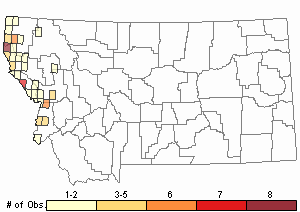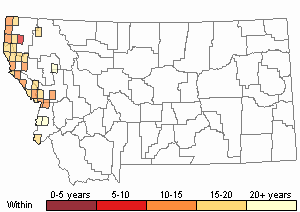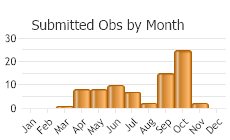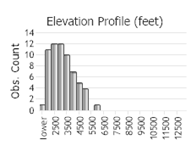View in other NatureServe Network Field Guides
NatureServe
Montana
Utah
Wyoming
Idaho
Wisconsin
British Columbia
South Carolina
Yukon
California
New York
Coeur d'Alene Oregonian - Cryptomastix mullani
Other Names:
Helix mullani, Triodopsis mullani, Polygyra devia blandi, Polygyra devia oregonensis, Polygyra devia mullani, Polygyra mullani
Native Species
Global Rank:
G4
State Rank:
S4
Agency Status
USFWS:
USFS:
BLM:
External Links
General Description
A medium shell, 12-17 mm diameter and up to 9.5 mm in height (variable among and within subspecies), heliciform to depressed heliciform, surface nearly smooth (hairy in C. m. tuckeri) with fine incremental and weak spiral striae, 5 to 6 whorls. Shell coloration is translucent to opaque brown. Aperture subtriangular and oblique, parietal tooth white, small and short to well-developed and triangular, lip thickened and recurved, whitish, sometimes with tooth-like thickenings; umbilicus partly or almost wholly covered by the lip; periphery rounded. Animal is dark gray on the head, tentacles, and back, lighter on the sole. The hairy immature shells of most subspecies eventually lose their hair (Hendricks 2012, Burke 2013). Internal anatomy is described by Pilsbry (1940).
There may be four subspecies: C. m. blandi, C. m. hemphilli, C. m. mullani, and C. m. olneyae. The validity of all subspecies needs to be reevaluated.
Diagnostic Characteristics
Mature individuals differ from most other species in Montana by a combination of size, presence of a flared or reflected lip around the aperture, and presence of a parietal tooth, which separates Cryptomastix from Allogona. C. sanburni differs from C. mullani by the long and tall parietal tooth (as opposed to a small triangular one) combined with a squarish palatal tooth and a blunt conic basal tooth (both lacking in C. mullani).
Species Range
Montana Range
Range Descriptions

 Native
Native
Range Comments
East of the Cascade Mountains from southeastern British Columbia and eastern Oregon to western Montana (Burke 2013). In Montana, reported west of the Continental Divide from seven counties: Flathead, Lake, Lincoln, Mineral, Missoula, Ravalli, Sanders. Elevation range is 655 to 1920 m (2150 to 6300 ft). Species may be abundant at some localities; 69 were reported from Sanders County in early October (Hendricks 2012).
Observations in Montana Natural Heritage Program Database
Number of Observations: 78
(Click on the following maps and charts to see full sized version)
Map Help and Descriptions
Relative Density

Recency



 (Observations spanning multiple months or years are excluded from time charts)
(Observations spanning multiple months or years are excluded from time charts)
Habitat
Forested to semi-open sites, often near moisture. Canopy species include western redcedar, western hemlock, grand fir, Engelmann spruce, subalpine fir, Douglas-fir, western larch, western white pine, lodgepole pine, ponderosa pine, black cottonwood, aspen, and paper birch; secondary canopy includes alder, dogwood, water birch, willow, and mountain maple. Often found under woody debris, rocks, bryophyte mats in talus, leaf litter, and duff (Hendricks 2012).
References
- Literature Cited AboveLegend:
 View Online Publication
View Online Publication Burke, T. E. 2013. Land snails and slugs of the Pacific Northwest. Corvallis, OR: Oregon State University Press. 344 p.
Burke, T. E. 2013. Land snails and slugs of the Pacific Northwest. Corvallis, OR: Oregon State University Press. 344 p. Hendricks, P. 2012. A Guide to the Land Snails and Slugs of Montana. A report to the U.S. Forest Service - Region 1. Montana Natural Heritage Program, Helena, MT. vii + 187 pp. plus appendices.
Hendricks, P. 2012. A Guide to the Land Snails and Slugs of Montana. A report to the U.S. Forest Service - Region 1. Montana Natural Heritage Program, Helena, MT. vii + 187 pp. plus appendices. Pilsbry, H.A. 1940. Land Mollusca of North America (north of Mexico), Volume 1 Part 2. Monograph of the Academy of Natural Sciences of Philadelphia Monograph Number 3(1): 574-994.
Pilsbry, H.A. 1940. Land Mollusca of North America (north of Mexico), Volume 1 Part 2. Monograph of the Academy of Natural Sciences of Philadelphia Monograph Number 3(1): 574-994.
- Additional ReferencesLegend:
 View Online Publication
View Online Publication
Do you know of a citation we're missing? Bland, T. and J.G. Cooper. 1861. Notice of land and freshwater shells collected by Dr. J.G. Cooper in the Rocky Mountains, etc, in 1860. Annals of the Lyceum of Natural History of New York 7:362-370.
Bland, T. and J.G. Cooper. 1861. Notice of land and freshwater shells collected by Dr. J.G. Cooper in the Rocky Mountains, etc, in 1860. Annals of the Lyceum of Natural History of New York 7:362-370. Cooper, J.G. 1868. The shells of Montana. American Naturalist 2:486-487.
Cooper, J.G. 1868. The shells of Montana. American Naturalist 2:486-487. Elrod, M.J. 1902. Daphnia pond, a study in environment. University of Montana Bulletin #16, Biological Series 5: 230-233.
Elrod, M.J. 1902. Daphnia pond, a study in environment. University of Montana Bulletin #16, Biological Series 5: 230-233. Forsyth, R.G. 2004. Land snails of British Columbia. Royal British Columbia Museum: Victoria, British Columbia, Canada. 188 pp.
Forsyth, R.G. 2004. Land snails of British Columbia. Royal British Columbia Museum: Victoria, British Columbia, Canada. 188 pp. Frest, T.J. and E.J. Johannes. 1995. Interior Columbia Basin mollusk species of special concern. Final report to the Interior Columbia Basin Ecosystem Management Project, Walla Walla, WA. Contract #43-0E00-4-9112. 274 pp. plus appendices.
Frest, T.J. and E.J. Johannes. 1995. Interior Columbia Basin mollusk species of special concern. Final report to the Interior Columbia Basin Ecosystem Management Project, Walla Walla, WA. Contract #43-0E00-4-9112. 274 pp. plus appendices. Frest, T.J. and E.J. Johannes. 1997. Land snail survey of the lower Salmon River drainage, Idaho. Idaho Bureau of Land Management Technical Bulletin No. 97-18.
Frest, T.J. and E.J. Johannes. 1997. Land snail survey of the lower Salmon River drainage, Idaho. Idaho Bureau of Land Management Technical Bulletin No. 97-18. Frest, T.J. and E.J. Johannes. 2001. An annotated checklist of Idaho land and freshwater mollusks. Journal of the Idaho Academy of Science 36(2):1-51.
Frest, T.J. and E.J. Johannes. 2001. An annotated checklist of Idaho land and freshwater mollusks. Journal of the Idaho Academy of Science 36(2):1-51. Henderson, J. 1924. Mollusca of Colorado, Utah, Montana, Idaho, and Wyoming. University of Colorado Studies 13(2):65-223.
Henderson, J. 1924. Mollusca of Colorado, Utah, Montana, Idaho, and Wyoming. University of Colorado Studies 13(2):65-223. Henderson, J. 1936. Mollusca of Colorado, Utah, Montana, Idaho, and Wyoming, supplement. University of Colorado Studies 23(2): 81-145.
Henderson, J. 1936. Mollusca of Colorado, Utah, Montana, Idaho, and Wyoming, supplement. University of Colorado Studies 23(2): 81-145. Hendricks, P. 2005. Surveys for animal species of concern in northwestern Montana. Unpublished report to the Montana Department of Fish, Wildlife & Parks, Montana Natural Heritage Program, Helena, Montana, May 2005. 53 p.
Hendricks, P. 2005. Surveys for animal species of concern in northwestern Montana. Unpublished report to the Montana Department of Fish, Wildlife & Parks, Montana Natural Heritage Program, Helena, Montana, May 2005. 53 p. Stabins, H. 2004. Forest owl and invertebrate monitoring report for northwestern Montana Plum Creek managed landscapes for 2003 and 2004. Plum Creek.
Stabins, H. 2004. Forest owl and invertebrate monitoring report for northwestern Montana Plum Creek managed landscapes for 2003 and 2004. Plum Creek. Vanatta, E.G. 1914. Montana shells. Proceedings of the Academy of Natural Sciences of Philadelphia 66:367-371.
Vanatta, E.G. 1914. Montana shells. Proceedings of the Academy of Natural Sciences of Philadelphia 66:367-371.
- Web Search Engines for Articles on "Coeur d'Alene Oregonian"
- Additional Sources of Information Related to "Snails / Slugs"





